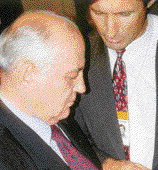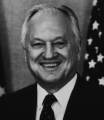
Mikhail
Gorbachev discusses the GENI solution with Peter
Meisen at the "State of the World Forum"
in San Fransisco in San Francisco on October
1, 1995.
What's
Being Said By the Experts:
The extensive international
cooperation necessary would mean alternative
expenditures to armaments, and at the same
time, help overcome social-economic problems
which exist today in developing countries.
Yevgeny
Velikhov, Vice-President, Russian Academy of
Sciences
Birthrates
decrease at exactly the same rate that the
per capita consumption of inanimate electrical
energy increases. The world's population will
stop increasing when and if the integrated
world electrical grid is realized. The grid
is the World Game's highest priority objective.
Dr.
R Buckminster Fuller, "Critical Path"
The most thoughtful and scientific solution
to the world's problems I've ever seen.
Ron
Williams, Senior Research Director, General
Motors

A global energy network makes enormous sense
if we are to meet global energy needs with a
minimal impact on the world's environment.Such
advances (in long distance transmission) may
even make possible the visionary suggestion
of Buckminster Fuller two decades ago that the
Eastern and Western hemispheres be linked by
underwater cable to assist each other in managing
peak energy demand, since the high daytime use
in one hemisphere occurs at precisely the low
night time consumption by the other.
Al
Gore, letter from former US Senator (Tennessee)
[Now Vice President], and "Earth in the Balance"

My conclusion is that to build
a new world -- to build peace -- we must literally
build it... Two billion people live without
electricity today. Show me any area in the world
where there is a lack of energy, and I'll show
you basic poverty. There is a direct tie-in
between energy and poverty, energy and war,
energy and peace. . . Electrical interconnections
between regions -- and even continents -- can
and must be tackled now. This can be a vast
and visionary undertaking -- worthy of our generation.
Walter
Hickel, Governor of Alaska, Chairman of Northern
Forum

The construction of long distance transmission
lines for the transport of the bulk hydroelectric
energy from its distant sources is the aim of
environmentalists as well as a hope for the
peoples of developing countries. The revenues
from the export of renewable hydro-energy would
pay back the investments in the power projects
and also provide financing for sustained economic
and social development.
Eng.
M Maher Abaza, Minister of Electricity and Energy,
Egypt
Throughout
most of the history of electric power, the
institutions that furnished it have tended
to be vertically integrated monopolies, each
within its own geographic area. Selling or
borrowing electric power among these entities
both for economy and for emergency back-up
has gradually grown until larger areas made
up of many independent organizations have
become physically connected for their own
mutual support. This wide area interconnection
is already international in its extent, especially
in Europe and the Americas. For instance,
the North American power network may realistically
be considered to be the largest machine in
the world since its transmission lines connect
all the electric generation and distribution
on the continent.
These interconnections already reduce the
impact of energy conversion on the environment
by allowing the most efficient sources of
power to be used regardless of their location.
It is the GENI vision to extend this network
to the entire globe and to make available,
everywhere, electricity generated from the
most sustainable sources of power, whose efficiency
is continually being increased through the
application of new technologies.
A major step toward the realization of this
vision would be the development of a realistic
model and simulation that could be used to
quantify the benefits of a global energy network
and specify the enabling technologies needed
to put it in place.
A.
Martin Wildberger, Ph.D., EPRI (Electric Power
Research Institute), Energy Delivery and Utilization
Division, Strategic Science and Technology Department
Inventor R. Buckminster Fuller first proposed
the idea of connecting the world's regional
electrical grids into a single global energy
network in 1969. Since then, political problems,
including domestic and international conflicts,
have posed a formidable barrier. However, the
development of long-range transmission systems
has bolstered the technological feasibility
of such plans. In recent years a number of government
agencies, utilities, and electrical equipment
manufacturers around the world have set aside
their geopolitical differences and joined forces
to build transmission systems that can economically
send thousands of megawatts across thousands
of kilometers.
Michael
Valenti, Associate Editor, "Mechanical Engineering"

We estimate that by 2050, electricity may account
for 60% to 70% of the energy consumed. . . because
of these trends there will be a growing trade
in power, not just between neighboring countries,
but across neighbor countries to a third country.
All this demands strong interconnections. Extra-high
voltage (EHV) transmission will become more
important for wheeling. Research into EHV in
the future is going to be of paramount importance.
Hisham Khatib, Chair, Committee on Energy
Issues in Developing Countries, Vice President,
World Energy Council
The exploitation of remote energy sources at
low cost (e.g. hydro or mine-mouth coal) is
now feasible and economical for distances never
before entertained. For example, transmission
systems can be set-up over a distance of as
much as 7000 kilometers in d.c. (direct current)
and 3000-4000 kilometers in a.c. (alternating
current) such that, by offering an acceptable
reliability level for the receiving system concerned,
present costs small enough as to make advantageous
the exploitation of these sources, when compared
to more expense generation located in the vicinity
of load centers.
Luigi
Paris, Giancarlo Manzoni, Nelson DeFranco, et
al. CIGRE (International Conference on Large
High Voltage Electric Systems) System Planning
Committee
With peace at hand, some ambitious development
projects no longer look so crazy. Beyond Israel
and the occupied territories, some other neighbors
could benefit too. A few of the Palestinians'
fondest dreams: Power Grids: Interlocking electricity
grids could save Israelis and Arabs millions
of dollars.
Newsweek
Magazine, Special Report on Middle East Peace
The levels of renewable
energy development indicated by this scenario
(Renewables Intensive Global Energy Scenario)
represent a tiny fraction of the potential for
renewable energy. Higher levels might be pursued
if society should seek greater reductions in
CO2 emissions. . . and that most electricity
produced from renewable sources would be fed
into large electrical grids and marketed by
electric utilities.
Johansson,
Kelly, Reddy, Williams "Renewable Energy: Sources
for Fuels and Electricity"

We must see the problem as a whole. We must
understand and explain to all other men on our
planet that the interconnection between power
systems of different countries is one of the
important tasks for all humanity.
Victor
Yershevich, Director of Science, Energoset Project
I had the good fortune
of meeting Buckminster Fuller many times and
getting to know him as a person and a gifted
genius. He had a profound devotion and commitment
to humanity in his world view into the future
as well as in time. His desire and purpose,
through a Design Science Revolution, was to
improve the quality of life on the planet. His
was a revolution for integrating and enhancing
human systems rather than taking them apart.
As we celebrate the Centennial of Buckminster
Fuller's birth, we share in his memory and in
the opportunity to study his philosophy as we
expressed in his work, to learn from this great
contemporary master how to make a more livable
world. Bucky's idea will continue to nourish
us all and will help us know what to do with
the option that is ours to improve our home
planet Earth.
Dr.
Jonas Salk, Discovered polio vaccine
The goal of an interconnected network for supplying
renewable resource based electrical energy for
the world's poorest is one of the most obvious
for everyone who controls the direction of technological
development. It should become the common rallying
point for the world's engineers and scientists.
Rustum
Roy, Director of the Materials Research Lab,
Pennsylvania State University

|